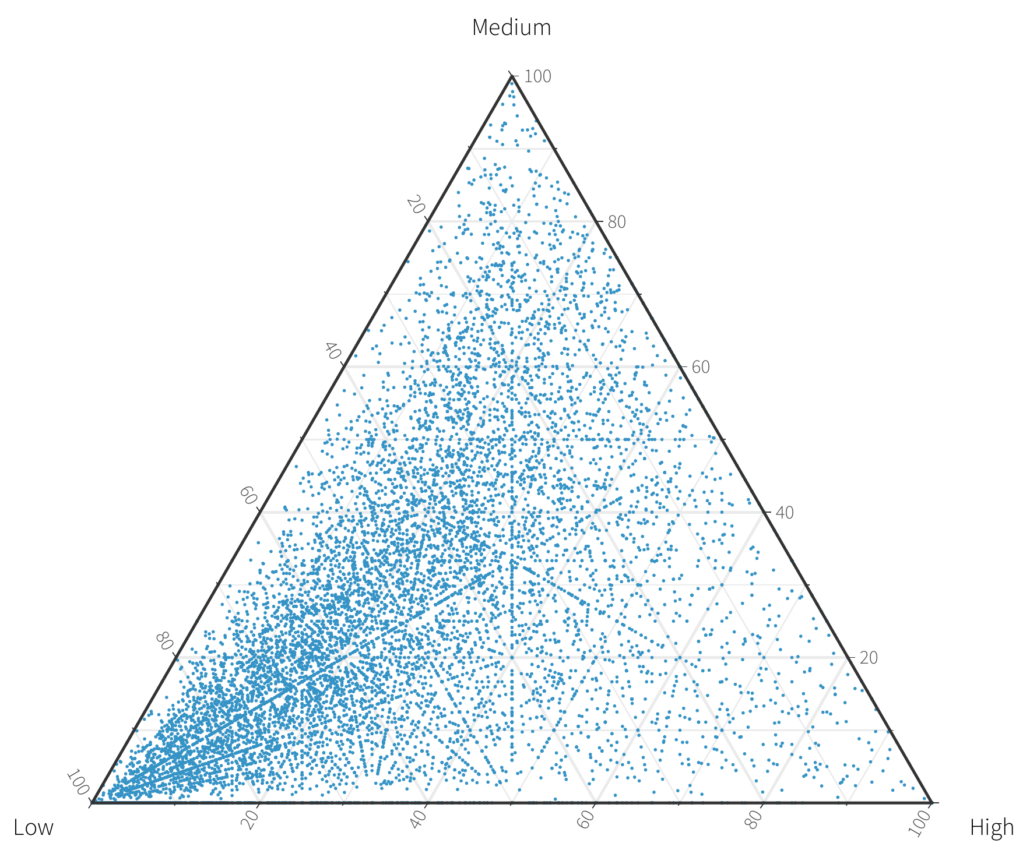

- #Ternary diagram generator generator
- #Ternary diagram generator software
- #Ternary diagram generator free
The following diagram makes it more clearĬonstructs a new default ternary plot generator with the default options.Ĭomputes coordinates that are scaled by the plot radius from ternary data. If vertices is not specified, returns the current vertices, which defaults to the vertices of an equilateral triangle with radius 1 with angles -90°, 150°, 30°.


If vertices is specified, sets the vertices to the specified array and returns this barycentric converter. If a is not specified, returns the current a-value accessor, which defaults to:Ĭomputes normalized ternary values by summing the of ternary data and taking proportions of it using the value accessors. If a is specified, sets the a-accessor to the specified function and returns this barycentric converter. Note that the coordinates here are unscaled i.e. All values are normalized by default.Ĭomputes ternary values from coordinates (a two-element array ). Note that the coordinates here are unscaled (radius of 1). By default, it makes an equilateral triangle on the unit circle centered at the origin.Ĭomputes coordinates from a ternary values (a single three-element array). ternaryPlot ( b ) API Reference barycentric()Ĭonstructs a new default ternary converter that converts ternary data to Cartesian coordinates. Pebbles in the lower Colorado River, Texas, a study in particle morphogenesis, Journal of Geology 66(2): 114-150.Const b = d3. Earth Surface Processes and Landforms 25(13): 1473-1477. Graphical representation of particle shape using triangular diagrams: an Excel spreadsheet method. Journal of Sedimentary Research A64(4): 910-915. Fabric shape and the interpretation of sedimentary fabric data. Tri-plot was developed whilst the authors were in receipt of studentships from the University of Wales, Aberystwyth (David Graham) and Liverpool John Moores University (Nicholas Midgley). WinZipped file containing all of the above files. The paper that describes the original version of Tri-plot. Downloadsīefore downloading, please ensure you have read and agree to the conditions of use outlined above. The original version of Tri-plot (as described in Graham & Midgley 2000) is available from the Earth Surface Processes and Landforms resources page on the Wiley Interscience website (). Users should satisfy themselves as to the suitability of Tri-plot for their intended application. To the extent permitted by law, no liability will be accepted for any losses whatsoever resulting directly or indirectly from the use of Tri-plot or the associated documentation.
#Ternary diagram generator software
The developers of Tri-plot make no warranty regarding (1) the suitability of Tri-plot for any particular application, or (2) the absence of errors in the software or documentation.
#Ternary diagram generator free
Users are free to distribute and modify the software provided that the original source and copyright are acknowledged in any modified version and that no attempt is made to pass off the derivative work as being the unmodified work of David Graham and Nicholas Midgley. Tri-plot, and all associated documentation, is copyright © 2003 David Graham and Nicholas Midgley. Tri-plot is made available free of charge subject to the condition that the original source (Graham and Midgley 2000) is referenced in all publications which utilise it. The latest version (1.3) supports the plotting of the Sneed & Folk (1958) shape classes and user-defined isolines of the oblate-prolate (Dobkins & Folk 1970) and maximum-projection sphericity (Sneed & Folk 1958) indices. Because Tri-plot is implemented in Microsoft® Excel, it has a familiar user interface and data can be easily cut-and-pasted into it. Tri-plot provides a simple method of producing both conventional and Sneed & Folk triangular diagrams. Figure 1: The conventional triangular diagramįigure 2: The Sneed & Folk triangular diagram. Existing software is unable to plot these diagrams as the parameters on the three axes do not sum to 1. This scaling of the triangular diagram may also be used to represent sedimentary fabric shape (Benn 1994) and has potential application wherever the relationships between three independent variables are compared. Numerous software packages are available for the production of such diagrams.Īn alternative type of triangular diagram was proposed by Sneed & Folk (1958) for the representation of particle shape (Fig. In the Earth Sciences, a common application is the representation of the proportions of sand, silt and clay in a sample. Tri-plot is a Microsoft® Excel spreadsheet for the preparation of triangular (ternary) diagrams for particle-shape and tri-variate data.Ĭonventional triangular diagrams are used to represent tri-variate data in which the three variables represent proportions of a whole (Fig. You are here: Resources Gateway home > Tri-plot Tri-plot


 0 kommentar(er)
0 kommentar(er)
